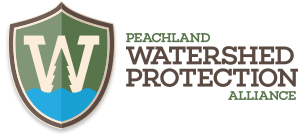On May 19, 2020 members of PWPA Forest Watch Committee joined representatives of Ntityix Resources on Syilx traditional lands at Spring Lake. The meeting and field trip was a joint action for the purpose of reviewing the temporary roads constructed by Ntityix through the Spring Lake area, and the advanced and innovative logging practices that Ntityix has implemented for this project.
Ntityix Resources had five representatives take part in this field trip.
Dave Gill, the General Manager of Forestry explained that Ntityix is attempting a new approach to forestry management practices and is basing their cutblock design and rate of cut on forest sustainability for 100 to 200 years in the future. This approach reflects the First Nation philosophy of being able to provide for seven generations ahead, and is guided by Syilx forestry standards, and Traditional Ecological Knowledge (TEK). Planning for a cutblock area takes into account existing wildlife habitat, existing stands of deciduous trees, particularly aspen, wetland and riparian areas, and forest bio-diversity. Mr. Gill explained that this new approach is less cost-effective than clear-cutting within the requirements of the current BC forestry regulations. However, he assured the representatives of PWPA that he and the Ntityix team were committed to exceeding those requirements in the areas where Ntityix is licensed to log.
Logging is never pretty, especially when it’s fresh. Members of the PWPA have many clear-cut areas in the Peachland watershed in the past. The devastating effects of this type of industrial tree harvesting have had a profound effect on all of our volunteers. The loss of wildlife habitat, the degradation of the soil and water, and the loss of indigenous species, can be overwhelming to experience. What was once a functioning ecosystem is reduced to what appears to be a wasteland, sometimes in less than a season.
What the members of PWPA observed during our time with the Ntityix team was far different than a clear-cut, and not the conventional, minimum standards logging practice widely accepted by government and industry across the province.
Spur roads will be temporary and will be rehabilitated after logging is completed. Skidder trails are utilized in numerous areas. These are less invasive than roadways. Selective logging is implemented in some areas. This ensured that some wildlife trees remained. Riparian areas near bodies of water and wetlands were left intact and protected. Uncut areas were plentiful and substantial in size, allowing for wildlife corridors and habitat.
Overall, the PWPA members who attended this field trip hope that this new initiative by Ntityix serves to provide a benchmark that other forestry companies will follow. The Syilx traditional lands and waterways, and all the inhabitants of these lands call out for it.
Thank you to Dave Gill, Mic Werstuik, Carson MacKenzie, Coulter Roberts and Al Peatt of Ntityix Resources for spending the time with the PWPA members and for sharing with us your knowledge and vision for the future. It is our hope that this is the beginning of an ongoing relationship, one in which we can continue to participate with Ntityix for the greater good.
Submitted by John Youngblut, Watershed Watch Chair, photos courtesy John Youngblut, photographer; Mirel Domsa, Pilot
Submitted by John Youngblut, Watershed Watch Chair, photos courtesy John Youngblut, photographer; Mirel Domsa, Pilot




